m (finetuning and pic add.) |
m (→CGI models: lnk.fx.) |
||
| Line 63: | Line 63: | ||
== CGI models == |
== CGI models == |
||
| − | A [[CGI model]] of a ''K't'inga''-class vessel, in fact one of the two very first CGI ships ever for ''Star Trek'', was built in 1981, but has not been seen by the general public. It was constructed as a probation piece at the [[Pixar|Graphics Group]] to convince mother company ILM and Paramount Pictures to go ahead with what would eventually became the [[Project Genesis|"Genesis Demo"]] in ''The Wrath of Khan''. Project leader [[Alvy Ray Smith]] recalled, "''It should be mentioned that we had already done one "mini-production" (in August '81) for ILM to show off our abilities. We had rendered a model of the Starship |
+ | A [[CGI model]] of a ''K't'inga''-class vessel, in fact one of the two very first CGI ships ever for ''Star Trek'', was built in 1981, but has not been seen by the general public. It was constructed as a probation piece at the [[Pixar|Graphics Group]] to convince mother company ILM and Paramount Pictures to go ahead with what would eventually became the [[Project Genesis|"Genesis Demo"]] in ''The Wrath of Khan''. Project leader [[Alvy Ray Smith]] recalled, "''It should be mentioned that we had already done one "mini-production" (in August '81) for ILM to show off our abilities. We had rendered a [[Constitution class model#CGI refit models|model of the Starship Enterprise]] chasing a Klingon ship in 3-dimensions, with appropriate lighting, coloring, etc. This was done using [[Loren Carpenter|Loren]]'s first working version of his 3-D rendering program "Reyes" (Renders Everything You Ever Saw). This mini-production had also featured several 2-D effects programmed by [[Pat Cole]] and [[Rob Cook]]. We believe that this demonstration was what prompted Paramount and ILM to ask us to do a piece of the final film.''" (''[[American Cinematographer]]'', October 1982, p. 1038) |
[[File:K't'inga class model wire-frame CGI model.png|thumb|left|Perez's wire-frame model]] |
[[File:K't'inga class model wire-frame CGI model.png|thumb|left|Perez's wire-frame model]] |
||
Revision as of 09:50, 18 July 2013
Template:Realworld

K't'inga-class IKS Kronos One
The design of the K't'inga-class was based on the D7 class class created by Matt Jefferies for Star Trek: The Original Series, which was, in turn based on the manta ray in both shape and color. (Star Trek: The Original Series Sketchbook) The studio model originally started out as belonging to the latter class. While the K't'inga-class, like its D7-class predecessor, has made only a limited amount of appearances, they, together, have remained the quintessential Klingon starship design.
The physical model
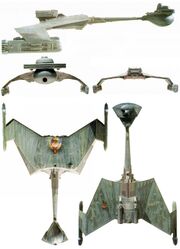
Orthographic views of the model in its oiginal livery
The original studio model, built in 1977/1978 for Star Trek: Phase II, was constructed at Magicam under supervision of Jim Dow, upgraded at Apogee, Inc., and measured a total of six feet in length (its actual dimensions being 47.5" × 35"). [1] It was based on molds taken from the original television D7-class studio model and was originally intended to be this class. When Phase II was upgraded to Star Trek: The Motion Picture, further refinement was deemed necessary to meet big screen requirements. Magicam/Astra Image Corporation started out with the requested upgrades as Art Director Richard Taylor recalled, "(...)that was built before we got involved. I redesigned all the surface textures, the photon torpedo tube and many other details. I tried to put a kind of bird-feather design on the surface. One of the things we did with all of the models was to give their surfaces details and interesting designs. A smooth object has no scale so it’s important in model work to find ways of creating scale. Sometimes it’s very subtle but it’s one of the most important elements in model photography. We did re-build the Klingon ships and that was one of the first things we finished, actually." [2], adding at a later point in time, "We also detailed out the Klingon ships adding detail to the bodies, the nose pod, the photon torpedo tube, and the bridge. I designed a new bird-like paint design for the wings and body of the Battle Cruisers.(...)Michael Sterling and I designed a new Star Fleet typeface, a Klingon typeface, and new logos for the Star Fleet and the Klingons." (Star Trek: Creating the Enterprise, p. 104) Andrew Probert further elaborated on the rework done on the model at that point in time,
"Due to continuing miscommunication with Magicam, the Klingon model eventually came to our Seward shop for additional detailing. We attempted to stay as close to the TV series version as possible, but after running some camera tests we discovered that an additional level of detail was needed for widescreen photography. A series of slides was taken of the model. We had photostats made of them and I did some initial design work on top of the stats. We painted it a darker color. I've always liked the idea of a black spaceship – which would have been impractical for this movie; so we came up with a dark military green. I had an idea that was carried out beautifully by Ron Gress. Ron painted a giant Klingon symbol on the underbelly of the ship. It was a revision of the old Klingon symbol." (Starlog, No.32, March 1980, p. 63)
Further upgrades on the model were taken over in 1979 by John Dykstra's Apogee's model shop, when that company was brought in by Douglas Trumbull. Dykstra recalled:
"That model, when it came to us, had been set up for some other photographic technique that didn't fit with ours. So we had to go in and completely redo the lighting. That was done by Grant McCune and the people he had working with him, which is basically a very similar staff to the ones we had on Star Wars and other shows. They did an incredible job. They took all the teeny little lights out of the model and put in some lights of significant size – and they did it in a matter of a few days. They really did a nice job of redoing the model, without destroying what was already there. They had to add a lot of detail to it because we got much closer to the model than I think they ever intended to do before. Once the thing with the ship was worked out, Doug Smith, in charge of shooting that sequence, photographed the opening shot." (American Cinematographer, February 1980, p. 174)
In the process the D7-class became the K'tinga-class. The most significant change in the design of the K't'inga model was its more detailed surface, so that it would look more believable on the movie screen. The K't'inga-class cruiser sequence shots for Star Trek: The Motion Picture were shot under the supervision of Dykstra. (Cinefex, No.1, 1980, pp. 4-34) The footage taken for this movie were the only ones taken of the model in this finish. [3] Later appearances in Star Trek II: The Wrath of Khan and Star Trek: The Next Generation were stock footage taken from this shoot.
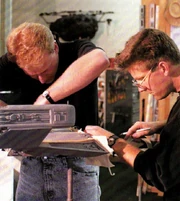
Goodson (l) and George refurbishing the model for it to become Kronos One
For Star Trek VI: The Undiscovered Country the original studio model, in 1991, underwent extensive modification to become Gorkon's flagship Kronos One. Originally, a new design for Gorkon's ship was considered, but budget restrictions, due to the dismal box-office performance of the previous movie outing, Star Trek V: The Final Frontier, made this impracticable, as Industrial Light & Magic (ILM)'s model maker Bill George recalled, "Paramount had already done some design work on this ship. Mark Moore and I did some additional sketches and I actually built a prototype. But it was ultimately decided that there wasn't money for this, so instead they decided to use the Klingon battlecruiser from Star Trek: The Motion Picture." That entailed more work than George had anticipated as the model had suffered from years of storage, but he made use of the opportunity to perform modifications. These, done at ILM's model shop by him, Moore, and John Goodson, involved a new paint scheme and gold colored metal etched ornaments applied all over the model. [4] George further elaborated:
"Originally, it was dark green in color; but after uncrating the model, we found it had been covered with a white water-based paint. It looked like someone had tried to clean it off, but that hadn't worked. Since we were going to have to repaint it, we thought that even if it wasn't a new model this was still going to be a special ship, so we figured we'd make it look different – distinctive from what we'd seen in previous films. Mark and I sent out to the library for books on military hardware; and out of that research, we came up with the concept that when Klingons return victorious from battle, they add some new piece of equipment or new graphics to their ships. We chose medieval armor as both our color palette and our design springboard and devised this regal and ornate looking paint job, which everyone liked and approved, so we transferred that look onto the model." (Cinefex, no.49, 1992, p.49)
In addition the warp engines were outfitted with internal lighting visible through newly-applied jagged slotted patterns to the hull. In this finish the model was only used twice more, in DS9: "The Way of the Warrior" and in VOY: "Flashback", as Kang's battle cruiser. In 1993 the model was on loan to Smithsonian Institution for their Star Trek Smithsonian Exhibit, where it was shortly re-united with its "mother", the original D7-class model. [5]
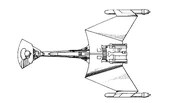
Design patent image
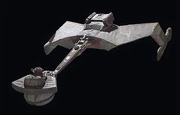
The model at auction in its Kronos One livery
A design patent, No. D263856, was issued by the US Patent and Trademark Office for the K't'inga on 4 April 1982 (there called a "toy spaceship") noted Andrew Probert as the sole "inventor" of the design. Filed on 7 May 1979, the patent, after being issued, was valid for fourteen years.
The original physical studio model was eventually listed as Lot #996 in the 40 Years of Star Trek: The Collection auction, where it was given an estimated sale price of US$3,000 to $5,000; it ultimately sold for US$85,000 ($102,000 with premium) on 7 October 2006. After its purchase, the owner hired Ed Miarecki's company, FX Models, to do restoration work and to build a custom made display cabinet for the model. [6]
Filming the physical model
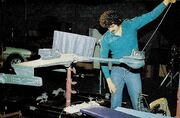
The modified model delivered at Apogee's filming facility
Apogee did not only modify the studio model, but was also responsible for shooting and compositing the opening Klingon-V'Ger sequence of The Motion Picture. Upon completion of the modifications, the model was delivered to Apogee's filming stage facility, at the time located in the San Fernando Valley, and John Dykstra started to ponder how to go about the sequence,
"So there were Klingon warships moving around in space with no cloud to go with them [rem: that visual effect had not been produced yet]. We got a model of the Klingon ship and looked at it to see what we could do with the bloody thing. We figured out some moves and storyboarded them and went over them with Bob Wise to see if he would go for them or not. We had to go over them with Doug [Trumbull], as well, because Doug, at the time, had the intention of generating the cloud in a way that was different from how it was finally generated. We provided moves that were very slow and deliberate, because Bob wanted to preserve a mass look in terms of the ships. Because of the way the cloud was to be generated, you couldn't move the ships very radically, the reason being that you couldn't duplicate that kind of move on the background. So it was hot using a conventional system–blue screen with one model." (American Cinematographer, February 1980, p. 174)
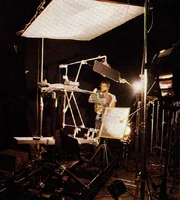
...with Greg Kimble adjusting the lighting on the model
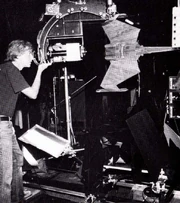
Smith programming the motion control system of the model prior to filming...

The model on set for blue screen photography
Once Dykstra had figured out the methodology, his crew of effects camera men went to work. Dykstra further recalled,
"We used the one Klingon model for the whole sequence–all bluescreen composite combination, except for the opening shot which was a double-pass matte deal. We used two passes on that to get a high-con matte because we couldn't do the roll-over trick and keep the bluescreen behind the model.
"Doug Smith was pretty much responsible for working that out. The whole idea was to come up with something that was nice and yet unusual. People are always coming to us and saying they don't want an opening shot that looks like Star Wars–they just want something that has the same impact. Well, that gets a little tough after awhile. The Star Wars opener was incredibly dramatic. It showed you the scale and the size of those ships, and it gave you a sense of speed that you don't normally get in a space environment. So it's an effective trick, but it's since been overused. The idea with the Klingons was to give us the same kind of visual impact, but without doing a real close flyby. (Cinefex, issue 2, p. 52)
"The cloud was shot with stars, which made it a composite element when it went into the optical printer to be put together with the other elements. All of the ships were separations. Some of them were run with cover mattes, and some without, depending upon how many passes there were. It was kind of tough getting the stars to hold up in some of them." (American Cinematographer, February 1980, p. 174)
Originally, the finale of the Klingon-V'Ger encounter was scripted in the latest script treatments of the direct precursor of The Motion Picture, the movie-upgrade of Star Trek: Phase II's "In Thy Image", as ending with the destruction of the Klingon vessels by V'Ger. To this end Magicam had breakaway models of the D7-class predecessor of the K't'inga-class studio model constructed, and these were already blown up and filmed at Robert Abel & Associates. By the time the project had become The Motion Picture, the sequence had changed to become the digitization of the vessels for storage in V'ger' databanks, and Dykstra had to come up with new visual effects to visualize the new ending.
In the movie, the Klingon ships, are hit by V'ger's energy bolts, they themselves called "Whiplash Bolts" by Dykstra and created by a Tesla coil, and amidst energy discharges evaporate, instead of blowing up. For the part were the ships are hit by lightning, also generated by a Tesla coil, additional model sculptures were constructed as Dykstra explained, "The real electrical discharge shows up in the Klingon sequence where the cloud fires it energy weapon and that great ball of blue energy comes out and envelopes the ship with electrical discharge all over its surface. It is real lightning done on a form that exactly matches the contours of the ship. Bruno George and David Sosalla sculptured a lot of those forms in the same shape as the ship. They matched them up in the format and then photographed the electric discharge actually crawling up over the surface of the forms." (American Cinematographer, February 1980, p. 195)
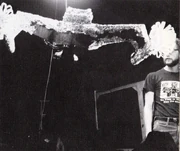
The in tin foil wrapped model awaiting its second scanning pass
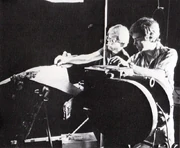
The model undergoing its first laser scan by Kimble and John Sullivan

The finalized digitizing effect as featured
The digitization and disappearances of the ships was an even more time consuming and elaborate process. Dykstra further explained,
"Then we went to a laser scan technique to create the disappearance, or digitization, of the Klingon ships. We used a smaller laser for that. It was five watts–which is still a pretty potent laser, but the problem is that when you start scanning it, you're essentially diluting the energy that it's putting out over a larger area and you end up with a limited amount of light. So the exposures had to be quite long. At first we'd scan just a small part of the model; and then we'd increase the scanned area on each subsequent frame so that the digitization effect would appear to be sweeping over the ship. The lines start out far apart and then get closer and closer together as they move across the surface. Then at the end there's something like an arc–a brilliant, flaring light which is supposed to indicate that the ship's molecular structure has been reduced to raw information and consumed by the cloud. It's been destroyed, but in a more elegant way than just blown up. It's violent and destructive, but the kicker–which you don't find out until later–is that the digitization is really a method of information storage. "To get the effect we wanted, we had two, and sometimes more, scanning passes to build up the image. We scanned the model itself; then we cover the model with foil and did another pass. That way we had a hard line for the initial scan and then a sparkling line following it. If the scan line wasn't coming out bight enough on one pass, we'd have to do a second. The we superimposed the scanned footage over the footage of the model itself, which was also in movement at the time. So it was a pretty complex process, and the scanning device that made it all possible was put together on very short notice by Al Miller and his electronics crew. After that was done, Harry Moreau and John Millerburg and the people up in the rotoscope department made frame-by-frame roto mattes so the ship would fade out and disappear." (Cinefex, issue 2, p. 56)
For all the complexity and time expenditure, Dykstra and his crew had to do it all over again with the Epsilon IX station enlarged panel model for its demise later on in the movie.
In the "Special Features" segment on disc seven of the VOY Season 3 DVD entitled Flashback to "Flashback", there is a 0:02:45 segment with Dan Curry discussing the filming of the encounter between the USS Excelsior and Kang's battle cruiser in the Azure Nebula for the Voyager episode.
Other physical models
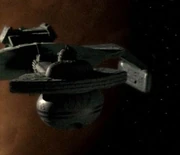
Unnamed K't'inga at the Surplus Depot Z-15
Though the K't'ingas shown in The Next Generation were all stock-footage taken from The Motion Picture, there was one exception with the appearance of an unnamed K't'inga-class at the Surplus Depot Z-15 in "Unification I", where a shot of the ship was used not covered by the footage. For the shot Gregory Jein, assisted by Bruce MacRae and Scott Schneider, built a separate model, using a set of the 1977 three feet molds of the D7 Jein owned. [7] This model was on tour in 1996 and 1997, appearing amongst others in the 1996 LA Star Trek Convention and in the BOSS Film Studios' model shop expo '97 in Los Angeles and seemed, a bit surprisingly perhaps considering the effort that went into the later "The Way of the Warrior" episode, not to have been used since in subsequent Star Trek productions.
In "Way of the Warrior" several other physicals models of the K'tinga were used for the massive battle scene, supervised by Dan Curry, Gary Hutzel, and Glenn Neufeld. These however were modified commercially available Playmates Toys {"We had to take out the sound effects", according to Judy Elkins), Hallmark Christmas ornaments and AMT/Ertl Star Trek model kits ("which blew up real good"). (Cinefantastique, Volume 28, No.4/5, p. 72; Star Trek: Deep Space Nine Companion, p. 263) Being the first mass battle scene ever shown on Star Trek, it was also the last one entirely done with physical models (save for a few shots with a CGI Defiant, the only one available at the time). Effects supervisor David Stipes had the procedure repeated with model kits for DS9: "Call to Arms", the last time physical models of the K't'inga were used. [8]
The heavily battle-damaged IKS B'Moth as seen in "Soldiers of the Empire" was a yet another separately-built model by Greg Jein, again using his set of the 1977 three feet molds of the D7. This model was on tour in 1997 shortly after filming and could be seen at the Star Trek Convention in Pasadena, 1997.
CGI models
A CGI model of a K't'inga-class vessel, in fact one of the two very first CGI ships ever for Star Trek, was built in 1981, but has not been seen by the general public. It was constructed as a probation piece at the Graphics Group to convince mother company ILM and Paramount Pictures to go ahead with what would eventually became the "Genesis Demo" in The Wrath of Khan. Project leader Alvy Ray Smith recalled, "It should be mentioned that we had already done one "mini-production" (in August '81) for ILM to show off our abilities. We had rendered a model of the Starship Enterprise chasing a Klingon ship in 3-dimensions, with appropriate lighting, coloring, etc. This was done using Loren's first working version of his 3-D rendering program "Reyes" (Renders Everything You Ever Saw). This mini-production had also featured several 2-D effects programmed by Pat Cole and Rob Cook. We believe that this demonstration was what prompted Paramount and ILM to ask us to do a piece of the final film." (American Cinematographer, October 1982, p. 1038)
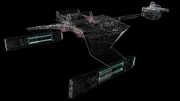
Perez's wire-frame model
Foundation's completed CGI model in action
A low resolution CGI model of the K't'inga-class was build years later at Foundation Imaging by Jose Perez for later appearances in Deep Space Nine and the Star Trek: Voyager episode "Prophecy" (although it was there misrepresented as a D7-class vessel), making its debut in "The Changing Face of Evil". [9](X) The CGI model was later enhanced by Adam Lebowitz and Robert Bonchune for representation in their book Star Trek: Starship Spotter. The CGI model made subsequent in-print appearances in the licensed Star Trek: Ships of the Line calendars series and their book derivative.
Apart form its "misuse" in the Voyager episode, the model was also "misused" as Vorok's battle cruiser in the later Star Trek: Enterprise episode, "Unexpected", where it was supposed to represent a more than a century-old design prior to the K't'inga design.
External links
- Klingon K'tinga-class Cruiser at StarshipModeler.com - includes over eighty close-up images of the actual shooting models from Star Trek: The Motion Picture and Star Trek VI: The Undiscovered Country
- The Everlasting Battlecruiser at Ex Astris Scientia: a comprehensive look at the lineage of the legendary Klingon battle cruiser
